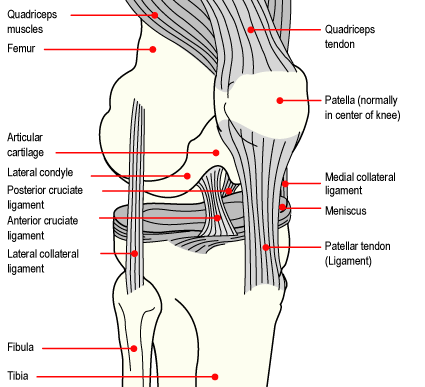Knee ‘ACL’ Anterior Cruciate Ligament Injuries
Function of the ACL
The primary function of the ACL is to provide stability in the knee and restrain anterior displacement of the tibia relative to the femur. It also acts to restrain internal-external rotation and varus-valgus angulations and combinations of. Therefore an injury to the ACL causes a loss in stability in the knee joint.

Causes
- Non-contact sudden deceleration force
- Quick unopposed force of quadriceps
- Contact force to posterior aspect of knee, but also to the sides is possible
What to Look For – Signs and Symptoms
- 72% with apparent hemarthrosis (blood accumulated in joint)
- “Pop” sound an time of injury
- Feeling of instability (giving way)
- High percent of ACL tears present with meniscal tears and collateral ligament injuries (Common is the Triad = ACL + MCL + Meniscus)
Classifications
- Grade 1 = small partial tear / sprain
- Grade 2 = moderate partial tear
- Grade 3 = complete rupture
Treatment and management
Proper treatment can only be applied when a correct diagnosis can be made. A clinical examination will help to assist this.
Initial Stage of Rehabilitation Phase 1 (0- 6 weeks)
- Swelling control: (PRICE) protect, rest, ice, compress, elevate
- Counter-act protective muscle spasms
- Restore pain free passive mobility (regaining full extension priority)
- Restore pain free active mobility
Intermediate Stage of Rehabilitation Phase 2 (6 weeks to 4 months)
- Continued increase in active and passive mobility of joint (regaining full range of mobility)
- Begin strengthening / muscle balance of knee and core stability
- Balance / proprioception
- Begin cardiovascular strengthening
Progressive Stage of Rehabilitation Phase 3 (4 to 8 months)
- Continued increase in active and passive mobility of joint
- Progressive strengthening / muscle balance of knee, lower extremities and core stability
- Progressive Balance / proprioception, exercise program
- Dynamic functional strengthening program return to high level activity
Research studies reveals that ALC tears are problematic because of functional instability, which results in meniscal injuries, secondary instabilities, and early onset osteoarthritis. Incidence of meniscal tear in ACL deficient knee is 40% at year one, 60% at year five, 80% at year ten. Osteoarthritis occurs in 60%-90% by year 10-15. Surgical intervention may be an option depending on the your current situation.
For more information about knee ACL injuries please contact InSync Physio.
References
- Eitzen I, Moksnes H, Snyder-Mackler L, Risberg M. A progressive 5-week exercise therapy program leads to significant improvement in knee function early after anterior cruciate ligament injury. JOPST. 2010; (40) 11, 705-721.
- Fitzgerald GK, Axe MJ, Snyder-Mackler L. A decision-making scheme for returning patients to high-level activity with nonoperative treatment after anterior cruciate rupture. Knee Surg Sports Traumatolog Arthros. 2000; 8:76-82.
- Hurd WJ, Axe MJ, Snyder-Mackler L. A 10 – year prospective trial of a patient management algorithm and screening examination for highly active individuals with anterior cruciate ligament injury, Part 1 Outcomes. Am J Sports Med. 2008; 36:40-47.
- Ibid, 48-56.
- Silvers H, Mandelbaum B. Prevention of anterior cruciate ligament injury in the female athlete. Br J Sports Med. 2007; 41: 152-159.